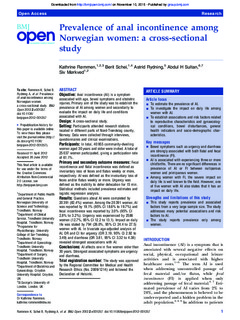| dc.contributor.author | Rømmen, Kathrine | |
| dc.contributor.author | Schei, Berit | |
| dc.contributor.author | Rydning, Astrid | |
| dc.contributor.author | Sultan, Abdul | |
| dc.contributor.author | Mørkved, Siv | |
| dc.date.accessioned | 2015-11-10T11:25:39Z | |
| dc.date.accessioned | 2015-11-20T15:35:09Z | |
| dc.date.available | 2015-11-10T11:25:39Z | |
| dc.date.available | 2015-11-20T15:35:09Z | |
| dc.date.issued | 2012 | |
| dc.identifier.citation | BMJ Open 2012, 2(4) | nb_NO |
| dc.identifier.issn | 2044-6055 | |
| dc.identifier.uri | http://hdl.handle.net/11250/2365050 | |
| dc.description.abstract | Objective: Anal incontinence (AI) is a symptom associated with age, bowel symptoms and obstetric injuries. Primary aim of the study was to establish the prevalence of AI among women and secondarily to evaluate the impact on daily life and conditions associated with AI.
Design: A cross-sectional study.
Setting: Participants attended research stations located in different parts of Nord-Trøndelag county, Norway. Data were collected through interviews, questionnaires and clinical examinations.
Participants: In total, 40 955 community-dwelling women aged 30 years and older were invited. A total of 25 037 women participated, giving a participation rate of 61.1%.
Primary and secondary outcome measures: Fecal incontinence and flatal incontinence was defined as involuntary loss of feces and flatus weekly or more, respectively. AI was defined as the involuntary loss of feces and/or flatus weekly or more. Urgency was defined as the inability to defer defecation for 15 min. Statistical methods included prevalence estimates and logistic regression analysis.
Results: Questions about AI were completed by 20 391 (82.4%) women. Among the 20 391 women, AI was reported by 19.1% (95% CI 18.6% to 19.7%) and fecal incontinence was reported by 3.0% (95% CI 2.8% to 3.2%). Urgency was experienced by 2586 women (12.7%, 95% CI 12.2 to 13.1). Impact on daily life was stated by 794 (26.0%, 95% CI 24.4 to 27.5) women with AI. In bivariate age-adjusted analysis of AI, OR and CI for urgency (OR 3.19, 95% CI 2.92 to 3.49) and diarrhoea (OR 3.81, 95% CI 3.32 to 4.38) revealed strongest associations with AI.
Conclusions: AI affects one in five women older than 30 years. Strongest associated symptoms are urgency and diarrhoea. | nb_NO |
| dc.language.iso | eng | nb_NO |
| dc.publisher | BMJ Publishing Group | nb_NO |
| dc.title | Prevalence of anal incontinence among Norwegian women: a cross-sectional study | nb_NO |
| dc.type | Journal article | nb_NO |
| dc.type | Peer reviewed | en_GB |
| dc.date.updated | 2015-11-10T11:25:39Z | |
| dc.source.volume | 2 | nb_NO |
| dc.source.journal | BMJ Open | nb_NO |
| dc.source.issue | 4 | nb_NO |
| dc.identifier.doi | 10.1136/bmjopen-2012-001257 | |
| dc.identifier.cristin | 1024249 | |
| dc.description.localcode | This is an open-access article distributed under the terms of the Creative Commons Attribution Non-commercial License, which permits use, distribution, and reproduction in any medium, provided the original work is properly cited, the use is non commercial and is otherwise in compliance with the license. See: http://creativecommons.org/licenses/by-nc/2.0/ and http://creativecommons.org/licenses/by-nc/2.0/legalcode. | nb_NO |
